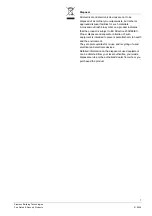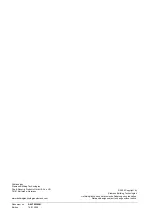
3
Siemens Building Technologies
Fire Safety & Security Products
01.2009
1
2
3
4
5
6
8
9
10
7
Fig. 1
Assembly
The SAP14 external power supply unit is designed for
mounting in dry indoor rooms. It must not be exposed to
dripping or splashing water.
1
Mounting holes for relay boards (optional)
2
Space for battery up to 12 V / 17 Ah
3 Cover
screw
4 Housing
5 Cable
inlets
6
Mains supply terminals with F7 fuse.
7 Transformer
SMU22
8
Power supply assembly circuit board SMP14
9
Eye for sealing.
10 Tamper
contact
Open cover
1.
Loosen cover screw (3) Fig. 1
2.
Remove cover
1
2
4
5
6
7
10
3
8
9
R45
F1
(B4+)
F2
(+1)
F3
(+3)
F4
(+4)
F5
(+6)
Fig. 2
Power supply assembly circuit board SMP14
1
LED flashes when E-bus communication is intact
2
Address button
3
Not used
4
E-Bus connection to burglary detection control unit
(B1-, B2, B3, B4+); B4+ is secured by F1.
5
4 o12 V (+1, +3, +4, +6), which are each secured
with a fuse (F2 to F5).
6
Output for mains supply indication (not fused).
7
1 relay output (1 pin 48 V / 5 A switching current)
8
Pre-wired battery terminal; protected by R45
9
Transformer terminal 20 V, 50 Hz
10
LED for mains supply indication
Fuses
No. Connection
Function
Type
F1
B4+
E-bus (12 V DC)
F2A F 250 V
F2
+1
+12 V DC
F2A F 250 V
F3
+3
+12 V DC
F2A F 250 V
F4
+4
+12 V DC
F2A F 250 V
F5
+6
+12 V DC
F2A F 250 V


























